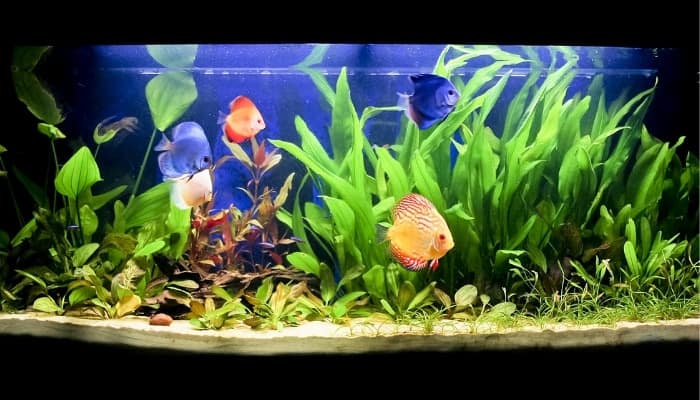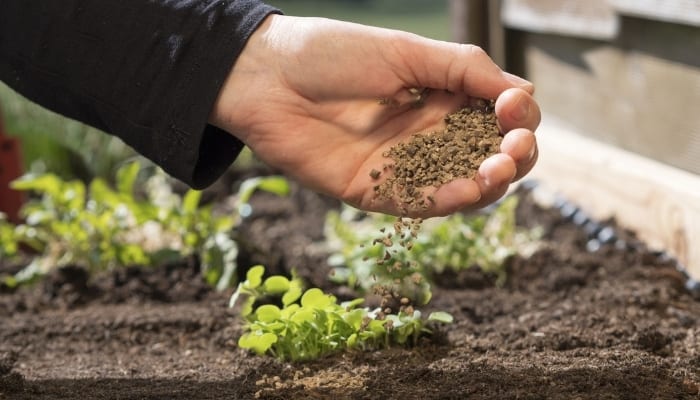Not all plants are compatible with commercial fertilizers. While they may be effective for houseplants and non-edible plants, it is important to seek out safer options for vegetables and fruits.
What can you use for plant food? There are many alternatives to commercial fertilizers that are safer to use and more cost effective. These include homemade compost, compost tea, manure tea, vermicompost tea, epsom salts, fish tank water, fish emulsion, kelp meal, blood meal, bone meal, banana peels, wood ashes, and coffee grounds.
While not all of these plant food fertilizers can be used with all types of plants, they still offer a less hazardous alternative to the commercial fertilizers packed with chemicals that would end up on our plates.
Read more to find out about these fertilizer alternatives.
14 Commercial Plant Food Alternatives
You should always make sure that the plant food alternative you use has all the nutrients that your plant needs.
1. Homemade Compost
Homemade compost is the most cost-effective way to get your hands on some plant food that costs you next to nothing while solving your garbage disposable problems.
The balanced compost pile should contain both green and brown materials, but you can add just about any food leftovers to it and stir it often to get it oxygenated.
2. Compost Tea
When your compost is ready, it should look like black or dark-brown dirt.
If your plants prefer liquid fertilizers, you can brew compost and water in the sun to create compost tea. It’s easier to apply and absorb and has all the organisms and benefits of the compost.
3. Manure Tea
If you have plenty of livestock, then you have a sustainable source of plant food that is both eco-friendly and cheap. Steep the manure in a bag in a bucket of water, and leave it there for a week or more.
Drain the tea to remove solids, and apply it to your garden and houseplants. It’s good for veggies and fruit patches in the garden.
4. Vermicompost Tea
Worms can be a great source of plant food. Tiny as they are, their droppings are rich in nutrients. Steep the worm droppings in water to make excellent and mild plant food.
Use it as the main fertilizer for plants that need little feeding, or you can use it as a plant food supplement along with compost.
5. Epsom Salts and Garden Lime (DIY Cal-Mag)
Some plants need more magnesium in the soil than others. This is true of potted plants in particular.
Epsom salts contain high doses of magnesium that keep the plants healthy and prevent fungal and viral infections. Add some garden lime, and you have a DIY version of a Cal-Mag fertilizer.
6. Fish Emulsion
Fish emulsion is rich in nitrogen and has an NPK of 4-1-1. It’s made either of whole fish or parts of the fish, including the bones, flesh, and skin.
To make a fish emulsion, you’ll need good size fresh fish, sawdust, and molasses. Add the ingredients to a large container and cover it for two weeks.
You can also purchase this from most gardening-supply stores. I personally use and recommend this organic one.
7. Fish Tank Water
Your fish in your aquarium relieve themselves every day and shed off dead skin cells. All of these make the water in the fish tank a valuable source of nutrients for the plants.
Instead of throwing out the dirty fish tank water, bottle it up, and use it to spray your veggies and fruits.

8. Kelp Meal
Kelp meal or kelp powder is harvested from the deep waters of the ocean, dried, and pulverized to create this organic fertilizer.
It’s ideal for organic gardening and small patches of veggies in the garden. However, treat it as a plant food supplement, not as a sole source of nutrients.
9. Bone Meal
Bone meal is the pulverized bones of large animals after they have been treated and dried. Bone meal is a good source of calcium and iron for many plants.
10. Blood Meal
The blood of slaughtered animals is collected, treated, and dried to create this powder. It contains high doses of nitrogen that most plants need. It’s also rich in proteins and is used to feed livestock.
11. Banana Peels
Banana peels tend to compost rather quickly. You can even use the raw banana peels as fertilizer as they break down just as fast in the elements.
Banana peel is rich in calcium and potassium and leaves the soil richer in nitrogen after it breaks down.
12. Molasses
While molasses do not have enough plant nutrients to be the only fertilizer needed, they do feed the microbes in the soil and trigger the production of chemicals that suppress pathogens and viruses in the soil and protect the plants against diseases.
13. Coffee Grounds
Coffee grounds contain high doses of nitrogen, but rather than adding the used coffee grounds to the soil directly, try composting the powder first.
The compost will be richer in nitrogen and trace amounts of other nutrients.
14. Wood Ashes
Wood ashes are another source of carbon and nitrogen that becomes easy to absorb by the plants. Clean the fireplace and sift through the ashes for debris, then mix the ash with the soil thoroughly.
Easy Homemade Plant Food Recipes
Whipping up your very own fertilizer is easier than you might think. Try these two simple recipes for yourself, and customize them the next time to further boost plant growth and health.
Epsom Salt Recipe
- Mix one teaspoon of Epsom salts, one teaspoon of baking soda, and half a teaspoon of ammonia in one gallon of water.
- Stir the water to get the ingredients to mix, and let it sit for half an hour.
- Spray the fertilizer or apply it directly to the soil.
Compost Tea
- Add several cups of finished compost to a tightly woven piece of fabric, like burlap or landscaping fabric, and close it securely.
- Drop the bag of compost into a 5-gallon bucket, and fill the bucket with water.
- Place a screen over the top of the bucket to keep bugs out, and let the tea “brew” in the sun for a couple of days.
- Remove the bag of compost, wringing out the water before adding it back to the compost pile.
- Use the compost tea as a foliar spray, or add it directly to the soil.
Related Questions:
Is Baking Soda Good for Plants?
Baking soda prevents fungal infections without causing harm to the plants themselves.
How To Add Potassium to Soil Naturally?
The best way to add potassium to soil naturally is to cut banana peels into 2-inch pieces and add them to the soil 2 inches deep. As the banana peels break down, they release potassium into the soil.
Conclusion
You can use food leftovers and other materials you throw out, such as fish tank water, to make excellent fertilizers for your plants.
These alternative food plants are no substitute for full-fledged fertilizers such as manure and compost, but they are a valuable source of natural nutrients that your plants will appreciate.

